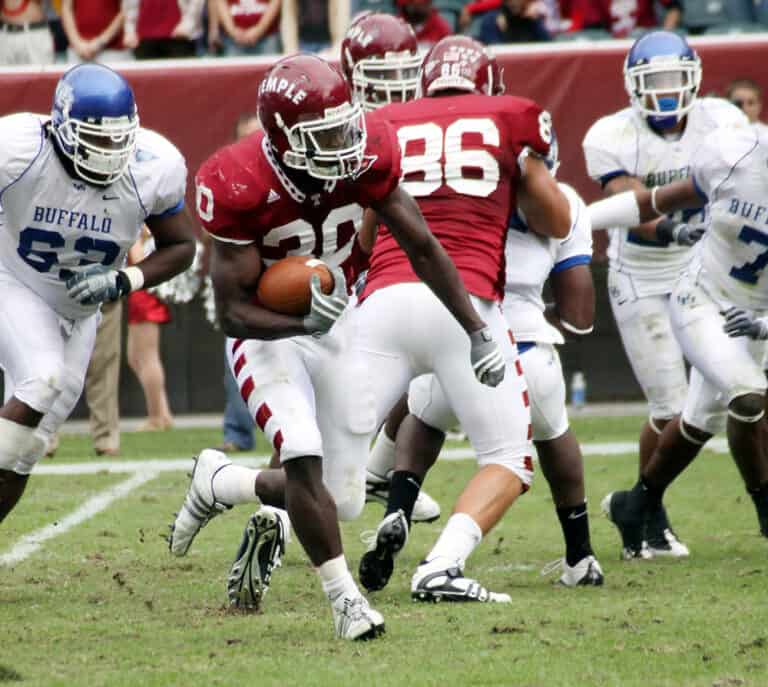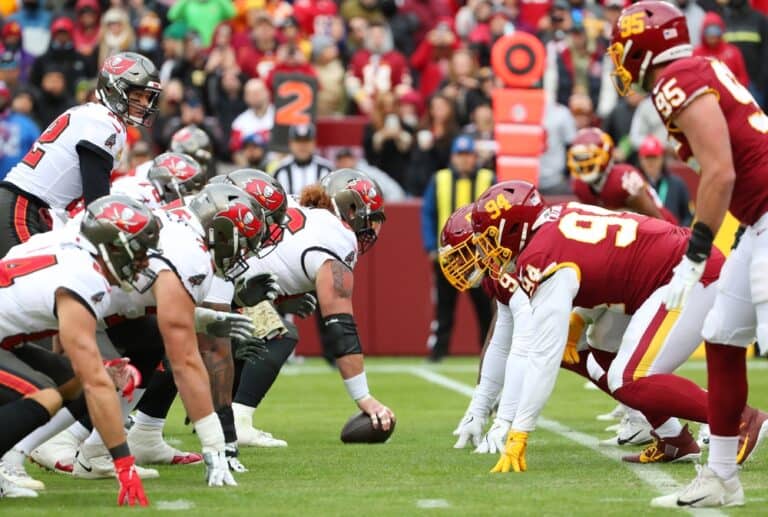Average Career Length Of An NFL Player
Sometimes abbreviated to “Not For Long,” NFL players have notoriously short careers compared to professional athletes from other sports. So what is the average length of an NFL player, and what factors result in their limited careers?
The average career length of an NFL player is two and a half years. While the leading cause is the physicality of the sport, the introduction of the collective bargaining agreement led to a much higher turnover rate of players with rookies from 2011 onwards.
To better all the factors which result in short playing careers, we will explore recent changes to the NFL in greater detail. Where after, we will look at each NFL position, NFL players who managed to have long careers, and what employment options are popular among retired players.
Why Do NFL Players Have Short Careers?
There are four primary reasons why NFL players have short careers:
- Injuries,
- The level of competition, and
- The collective bargaining agreement (CBA)
- Mental exhaustion.
1. Injuries
The most apparent reason for short playing careers is the physicality of American football. Namely, American football is a full-contact sport that encourages aggressive defensive techniques like hard tackles and shoulder charges to stop the opposition.
Furthermore, while American football players wear helmets, these helmets have shown to have little to no protection against frequent head trauma, which can lead to multiple concussions.
Consequently, while the risk of injury and the strain your body takes while playing American football has always resulted in short playing careers since its inception, the recent scientific discoveries surrounding the dangers of concussion mean that players will be medically discharged sooner than in previous decades.
Finally, because most NFL players start their careers after playing in equally competitive and physical teams like college football (see below for further details), the average age of an NFL player is 26.
While 26 is not considered old, there is a limited amount of physical punishment one’s body can take toward their late twenties; hence many NFL players retire at approximately 30 years of age.
2. The Level Of Competition
While the history of the NFL may have favored longevity for coaches and players developing cohesive strategies, the level of competition and financial risks among NFL teams has led to the commercialization of the sport and a decreased margin for error.
Therefore, relying purely on tried and tested strategic options and player cohesion is unlikely to yield results, given the speed of the sport’s evolution from season to season. Therefore, even if players and coaches yield excellent results one season, poor results the following season can quickly lead to replacements by a team’s decision-makers/shareholders.
Finally, at only 32 professional teams with 53 players in a squad, there are 1696 NFL players at any given time. Although this may seem like many players, there are no viable minor league options in the NFL, save for the tens of thousands of college players vying for a position in the NFL.
Consequently, should a current player’s price not match his skill, fitness, and/or physicality, he is at risk of being dropped in favor of younger talent from a vast pool of players. The pressure for a team to drop an expensive player in favor of a new, cheaper prospect is further exacerbated by the NFL’s salary cap per team!
Understandably, once a player is dropped from a team with little to no prospects of resigning with another NFL team, they will likely resign from playing football entirely.
3. Collective Bargaining Agreement (CBA)
An interesting development in NFL which has resulted in shorter player careers is the introduction of the Collective Bargaining Agreement (CBA.) According to the Wall Street Journal, the average career length of an NFL player dropped from 4.99 years in 2008 to 2.66 years in 2015 (a nearly fifty percent decrease!)
While injuries and the physicality of the sport were believed to be the main factor in decreased career lengths, two important data points challenge this hypothesis:
- There was a notable drop in career length from 2011 onwards, and
- The average length for all positions is shortened, including positions that are exposed to limited physical contact.
Consequently, because the Collective Bargaining Agreement (CBA) was introduced in 2011, this has been cited as a possible explanation for reducing career lengths across all positions.
Simply put, the Collective Bargaining Agreement (CBA) increased training camp rosters from 75 players to 95 players (essentially resulting in a 126% pool of players that can challenge existing NFL positions.)
Further to the above, the CBA with the NFL salary cap means that some pundits have argued that new players being drafted into the NFL are being deliberately drafted as cheap players to fill a short-term position, rather than teams attempting to maximize the longevity of a position with a genuinely talented player, (note: many fans and pundits dispute this theory, although it deserves mention.)
4. Mental Exhaustion
Finally, the mental stresses and pressure of professional sport is a well-documented phenomenon, where few players can meet the physical demands of professional sport, along with the added pressure of fame, press conferences, news media, etc.
Couple these personal mental challenges with external forces like challenges to one’s position, pressure from coaches, pressure from team managers, and the intensity of hostile crowds/playing grounds, and, understandably, many players lack the mental fortitude to play in the NFL for long periods.
Finally, while NFL players have short careers, they typically receive large salaries and favorable sponsorship endorsements. Thus it’s not uncommon to hear some players becoming distracted with material goods/experiences and forego the level of high-intensity training needed to remain in the NFL.
What Is The Average Career Length Of NFL Players Per Position?
While subject to variation, the Wall Street Journal read with the findings of Statista would suggest an approximate career average of each NFL position as follows:
- Kickers (4.87 years)
- Offensive linemen (3.8 years)
- Defensive back (3.2 years)
- Quarterback (3.1 years)
- Linebacker (3 years)
- Defensive lineman (3 years)
- Tight end (2.8 years)
- Running back (2.5 years)
- Wide receiver (2.2 years)
As is evident, positions that focus less on raw speed and physicality tend to have longer careers than those that do (like how kickers typically have longer salaries than wide receivers.)
In conclusion, while career longevity is a decent measure of an NFL player’s talent and ability, this should be seen within the context of their position’s average lifespan and their accomplishments during their window of “peak performance.”

Which NFL Players Had The Longest Careers?
Although NFL players typically have very short careers, some players have retained their spot in the NFL over multiple seasons.
- Morten Anderson (Kicker: 383 games and 26 years in the NFL)
- Adam Vinatieri (Kicker: 365 games and 23 years in the NFL)
- Gary Anderson (Kicker: 353 games and 22 years in the NFL)
- Jeff Feagles (Punter: 352 games and 21 years in the NFL)
- George Blanda (Quarterback/kicker: 340 games and 24 years in the NFL)
- Jason Hanson (Kicker: 327 games and 20 years in the NFL)
- Tom Brady (Quarterback: 318 games and still playing after 21 years in the NFL)
- Phil Dawson (Kicker: 305 games and 19 years in the NFL)
- Jerry Rice (Wide Receiver: 303 games and 29 years in the NFL)
- John Carney (Kicker: 302 games and 22 years in the NFL – tied tenth)
- Brett Favre (Kicker: 302 games and 19 years in the NFL – tied tenth)
How Long Does It Take To Become An NFL Player?
While prospective NFL players must be three years out of high school if they want to progress to the NFL, most players do not start playing American football within that cut-off period.
Instead, it is common for NFL players to dedicate most of their lives starting from “pee-wee” football at age seven, through middle school, high school, and college, before progressing to the NFL via the draft season.
In conclusion, like most professional sports, many NFL players will have played football for approximately 15 years before they enter a professional squad.
What Do NFL Players Do After Retirement?
Although NFL players typically make excellent salaries, however, they typically make far less over their careers than other professional athletes in the NBA, NHL, and MLB.
In fact, the only reason NFL salaries on average remain competitive with other sports is because of the enormous, outlying salaries afforded to quarterbacks (typically between 20 and 30 million dollars a year!)
Consequently, many NFL players consider their retirement options carefully so that they can continue to earn a salary and support their lifestyles post-NFL. The most popular industries for retired NFL players are:
- Entrepreneur/business owner: 20%
- Sales: 18%
- Fitness coach: 9%
- Finance and banking: 8%
- Campus/professional athletes: 5%
- Media and broadcasting: 3%
- Real estate: 3%
- Education: 3%
- Non-profit: 2%
- Other: 23%
Further to the above, the focus on sales, finance, and business means that many NFL players pursue MBAs and/or similar business degrees post retirement – as reported by ESPN in 2016.
Conclusion
In conclusion, numerous factors contribute to the short careers of NFL players. Fortunately, with the proper support, many NFL players are able to retire and build careers in various industries!
References
- https://work.chron.com/likelihood-someone-becoming-professional-sports-player-26110.html
- https://www.sportscasting.com/how-long-is-the-average-nfl-career/
- https://www.espn.com/blog/nflnation/post/_/id/207780/current-and-former-nfl-players-in-the-drivers-seat-after-completing-mba-program
- https://www.footballoutsiders.com/stat-analysis/2016/are-nfl-careers-really-getting-shorter
- https://bleacherreport.com/articles/1683775-when-does-age-catch-up-to-nfl-players
- https://www.quora.com/Why-are-quarterbacks-generally-able-to-play-longer-than-players-of-other-positions
- https://sportsnaut.com/10-players-with-the-longest-nfl-careers/
- https://www.quora.com/How-long-does-it-typically-take-to-become-a-professional-football-player-for-the-NFL
- https://www.forbes.com/sites/kurtbadenhausen/2017/01/31/what-jobs-nfl-players-do-after-they-retire/?sh=4965bc9b5b18
- https://www.statista.com/statistics/240102/average-player-career-length-in-the-national-football-league/







